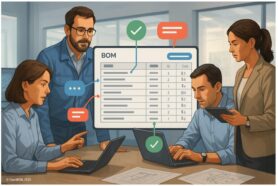
In my article today, I want to continue to share ideas about how to organize new types of agentic workflows in engineering teams and manufacturing companies, and explore how this type of workflows—powered by rich data and collaborative intelligence—can redefining the way manufacturing teams work together.
This builds on the plan I shared earlier this week in the article “Zapier for Engineering”—an idea that clearly resonated with many readers. Thanks for all the thoughtful feedback, both online and in private conversations.
The core insight behind that article is about new type of communication that involves people and systems in manufacturing eco-systems- engineers, production planners, contractors, suppliers, etc. The status quo is messy – teams are surrounded by tools that “almost” work together with a lot of integrations, custom script, a fragile Excel export, or another spreadsheet floating in someone’s inbox or shared drive. It brings a lot of pain that I see every day when discussing OpenBOM solution with prospects.
The plan is to make workflows smarter, more automated, and more connected—by design, not by patchwork. To make that happen, we need two things: (1) rich data and (2) robust flow.
Let’s talk about how we plan this new type of workflow to work.
Files, Emails, Databases, Workflows… What is Next?
Let’s zoom out for a moment. For decades, work organization followed familiar paradigms: files and folders, emails and attachments. Then came the rise of databases and structured workflows—improvements, but still often siloed and database-centric. To have a single database (or enterprise systems) was the “PLM Holy Grail”. For enterprise, it ended up with many special integrations. For smaller organizations it is a spread of CAD data, Excels, emails, and other files.
So, where does it go, and what’s the next step?
The next step brings a combination of modern data management with proactive AI workflows, forming the new type of a workflow – agentic workflows – where actions are triggered not just by human users, but also by intelligent agents and tools acting on rich, contextual data and language models.
Think about a chat started by a project manager to prepare new quantity report for the next build triggering automatic BOM calculations and generation of an order to be reviewed by a procurement person and automatic sending PO orders to suppliers and contractors.
To make it happen requires a few key ingredients:
- More flexible and powerful databases – we need data models that reflect the true complexity of product development.
- Real-time connectivity between systems and people – work doesn’t happen in one place, and neither should your data.
- Agent-driven collaboration – autonomous agents (AI and system-tool) that understand structure, context, and intent.
The Role of OpenBOM Collaborative Workspace
This is where OpenBOM Collaborative Workspace comes into play. The core of the OpenBOM platform is a Product Knowledge Graph—a flexible graph-based data model designed to represent complex product information across disciplines and company boundaries.
OpenBOM’s Collaborative Workspace extends this knowledge graph by enabling multiple users and systems (including AI agents) to work asynchronously, yet contextually, on a shared dataset. Think of it as the digital thread—connecting data silos and organizations. It’s a dynamic, interconnected web of objects, tasks, documents, and actions.
What makes it special?
- Multi-tenant architecture – Enables secure data sharing across teams and companies, not just within one organization.
- Real-time object-level updates – No more waiting for a file to be checked in; the workspace reflects changes live.
- API and agent-ready – Data can be created, consumed, and updated both manually and programmatically—by people, specific system tools, an AI agents.
From Messages to Agentic Flow
Imagine engineering communication not as a sequence of emails, but as a structured flow of connected messages, each enriched with context and linked directly to data: parts, BOMs, tasks, approvals. These messages are not emails; they are part of the communication built into the system. They can trigger workflows, notify stakeholders, or prompt an AI agent to suggest alternatives, flag risks, or initiate procurement steps.
This is how we plan this agentic flow to work. It’s not just automation script sending files from point A to point B—it’s collaboration at the data level, with human and non-human agents working together.
Why This Matters
The difference between simple administrative workflows (like those automated with tools like Zapier) and complex engineering workflows lies in the data model complexity. OpenBOM isn’t just passing messages and files between systems. It’s managing structured, deeply interconnected product data—enabling workflows that are meaningful for engineers, buyers, suppliers, and beyond to get the right data contextually at the right time to perform an action or pass it forward.
When your data is rich, connected, and accessible in real-time, your workflows become contextual with specific actions that can be triggered based on product structure and changes. Design updates can cascade intelligently. AI agents can reason over your BOMs—not as Excel, but as semantically structured product data.
Conclusion and Looking Ahead
We’re experimenting with scenarios where OpenBOM agent assist engineering teams with BOM updates, procurement planning, impact analysis, and change tracking. These agent use OpenBOM API and graph model to act with precision and context—exactly what’s needed in complex manufacturing environments.
We’re looking for forward-thinking teams to collaborate with us in shaping this future of this new agentic workflow. If you’re curious about improving a way of communication and organizing your companies workflows more efficiently, connecting multiple tools into a living collaborative workspace, let’s talk.
Because the future of manufacturing isn’t just about converting from documents to data—it’s about connecting people, data, and decisions into a single, intelligent thread.
Want to discuss it? Reach out to us – we are happy to discuss.
Best, Oleg
Join our newsletter to receive a weekly portion of news, articles, and tips about OpenBOM and our community.










